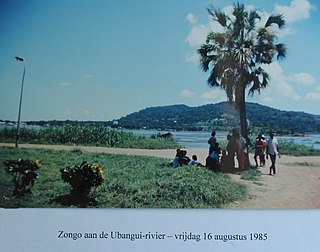19th century
|
|---|
 |
- 1889 - French military post established at crossing of Mpoko River and Ubangi River. [1]
- 1891 - French military post relocated to present site of city. [1]
The following is a timeline of the history of the city of Bangui, Central African Republic.
|
|---|
 |
| | This section needs expansion. You can help by adding to it. (July 2017) |

Bangui is the capital and largest city of the Central African Republic. It was established as a French outpost in 1889 and named after its location on the northern bank of the Ubangi River ; the Ubangi itself was named from the Bobangi word for the "rapids" located beside the settlement, which marked the end of navigable water north from Brazzaville. The majority of the population of the Central African Republic lives in the western parts of the country, in Bangui and the surrounding area.

David Dacko was a Central African politician who served as the first President of the Central African Republic from 14 August 1960 to 1 January 1966 and as the third President of the Central African Republic from 21 September 1979 to 1 September 1981. He also served as Prime Minister of the Central African Republic from 1 May 1959 to 14 August 1960. After his second removal from power in a coup d'état led by General André Kolingba, he pursued an active career as an opposition politician and presidential candidate with many loyal supporters; Dacko was an important political figure in the country for over 50 years.

Zongo is a city in Sud-Ubangi Province in the northwestern part of the Democratic Republic of Congo, lying on the south bank of the Ubangi River, across from Bangui in the Central African Republic. It is linked by ferry to Bangui but has declined in importance as a transport hub since much traffic moved east in the late 1980s.

The Movement for the Social Evolution of Black Africa was a political party in the Central African Republic. In its original form, it was a nationalist quasi-religious party that sought to affirm black humanity and advocated for the independence of Ubangi-Shari, then a French colonial territory.
Étienne Ngounio was a Central African politician. He became a member of the French Senate in 1958.
The following is a timeline of the history of the city of Dakar, Senegal.

Operation Sangaris was a military intervention of the French military in the Central African Republic, from late 2013 till 2016. It was the seventh French military intervention there since the independence of the country in 1960. On 30 October 2016, France announced it officially ended Operation Sangaris.
The following is a timeline of the history of Djibouti, Djibouti.

Roger Léon Charles Guérillot was a French colonist of Ubangi-Shari who was involved in the process of independence by which it became the Central African Republic.
Georges Darlan was a Central African politician. He was the president of the Representative Council of Ubangi-Shari from 1949 to 1952, the institutional predecessor of the Central African National Assembly.
The following is a timeline of the history of the city of Bamako, Mali.
The following is a timeline of the history of the city of Niamey, Niger.
The following is a timeline of the history of the city of Libreville, Gabon.
The following is a timeline of the history of the city of Yaoundé, Cameroon.
The following is a timeline of the history of the city of Brazzaville, Republic of the Congo.
The following is a timeline of the history of the city of Saint-Louis, Senegal.
The following is a timeline of the history of the city of Lubumbashi, Democratic Republic of the Congo.
The following is a timeline of the history of the city of Bukavu, Democratic Republic of the Congo.
The Renaissance Palace is the official residence of the President of the Central African Republic, located in the 1st arrondissement of Bangui, at the foot of Gbazabangui Hill and facing the PK zéro.
This article incorporates information from the French Wikipedia and German Wikipedia.